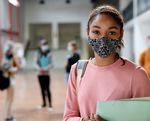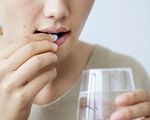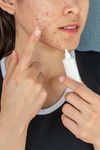This special edition of Spot On summarises the acne research presented within the All About Acne session of the 2021 Australasian College of ...
←
→
Page content transcription
If your browser does not render page correctly, please read the page content below
spot
Acne research reviewed & curated by
Australian dermatologists
July 2021
on
This special edition of Spot On summarises the acne research
presented within the All About Acne session of the 2021
Australasian College of Dermatologists Annual Scientific
Meeting held in April 2021.
What’s in the journals The role of biofilm formation in
(Ones you might have missed and latest trends) noninflammatory comedones
& inflammatory lesions
Philip Tong, Deputy Director of Research, A paper by Manisha Loss and colleagues
The Skin Hospital, Sydney looked at the role of biofilm formation in
noninflammatory comedones and inflammatory
Dr Tong is a dermatologist in private practice in Sydney
and a visiting specialist at St Vincent’s Hospital. He
lesions in acne vulgaris. This small study of
is also the Deputy Director of Research at The Skin adults found that biofilms were most often
Hospital and leads translational research at The found in comedones (55.6%) compared
Centenary Institute. He speaks widely on skin to inflamed or uninvolved skin (22.2%).
health and has a special interest in acne and Comedones were significantly enriched with
acne scarring. Staphylococcus compared to unaffected
skin. It’s not clear whether Staphylococcus
A review of transcriptome profiles in acne patients contributes to biofilm, or if the biofilm
treated with isotretinoin environment allows Staphylococcus to flourish.
biofilm microbiome 4
Yuchen Jiang and colleagues looked at transcriptome profiles in acne patients
successfully treated with isotretinoin, compared to those unsuccessfully treated.
The role of the gut-skin axis in acne
The study of patients with severe acne found that there was a differential gene
Britta De Pessemier and colleagues reviewed
profile expression between those that responded to isotretinoin and those that
current knowledge of the gut-skin axis. They
did not respond to isotretinoin. Transcriptome expression is involved in acne
found that acne patients have a distinct
pathogenesis, and may indicate a personalised therapeutic approach to acne
gut microbiome composition with reduced
patients. isotretionoin 1
diversity, but there’s still insufficient evidence
Can skin and hair changes be mitigated with biotin of any benefits of using probiotics in treating
A study by Sema Aksac and colleagues looked at biophysical skin parameters and acne. Diet plays some role in acne, particularly
hair changes in patients treated with isotretinoin treatment, and whether side saturated fats and foods with a high glycaemic
effects can be mitigated with biotin. The study found that supplements with 10mg/ index load, and is thought to cause acne
day of biotin maintained skin hydration, while decreasing telogen hair ratio and through a disturbed nutrient signalling pathway
increasing anagen hair ratio. More evidence is needed but the results of this small through SREBP-1, causing increased fatty acids
study are promising. isotretionoin 2 and triglycerides production in sebum, and
stimulated C. acnes. biofilm microbiome 5
A review of Clascoterone
cream, a topical androgen How electric fields affect biofilm
receptor inhibitor formation in C. acnes
Clascoterone cream, a topical androgen A paper looking at emerging therapeutics by
receptor inhibitor, has been reviewed by Asia Poudel and colleagues examined how
Michael Gold. The cream blocks testosterone electric fields affect biofilm formation in C.
in sebaceous glands and dermal papilla acnes. Electrical fields are currently being
cells, and inhibits synthesis of inflammatory used to inactivate microbes in liquid food and
cytokines. This review found there was wastewater. Nanosecond pulsed electric fields
an abnormal HPA axis response in three have been found to affect bacterial cell viability.
patients, but there was no evidence of adrenal The researchers found that electric fields affect
suppression. In one double-blinded randomised the viability of C. acnes in biofilms more than
controlled study, Clascoterone cream was those in suspension, possibly by affecting the
found to be more effective than placebo, but extracellular matrix and outer membrane,
another study did not demonstrate statistical as well as the biological processes crucial for
significance when compared with 0.05% microbial survival. emerging therapeutics 6
tretinoin. emerging therapeutics 3
1 • SPOT ON • All About Acne • Special ACD ASM Edition, July 2021Local research studies
Word on
the street
Individuals report by Philip Tong
spending an
average of $850
over a six month
period on acne Many healthcare
treatments, most professionals are
of which is spent seeing individuals with
on over-the- “maskne”, where face
counter products. masks are triggering
outbreaks of acne.
The financial costs of acne: Costs incurred by patients
with acne before dermatological consultations
When patients are seeking treatment for acne, they’re more likely to
consult their friends, family and the internet before doctors.
Many patients with acne try over-the-counter remedies before seeing a
doctor, but few of these OTC therapies are evidence-based. Population-
based studies have shown that many patients don’t seek medical advice,
even if their acne is significantly impacting their quality of life.
How to treat “maskne”
You might have patients who experienced
Few studies into acne treatment consider the financial cost to patients, “maskne” during the pandemic, where face
and few have examined those costs in relation to patient income. This masks trigger acne outbreaks.
study sets out to determine the financial costs of managing acne before
patients saw a dermatologist, and whether that spending correlated with It’s a variant of acne mechanica and the
income. The hypothesis was that patients would prioritise spending on triggers include follicular occlusion and
acne treatments, regardless of their level of income. mechanical stress – pressure, occlusion
and fiction – as well as dysbiosis in the skin
Patients at a Melbourne clinic were asked about their spending on any
caused by heat, pH and moisture. It can also
kind of acne treatment over the previous six months. For those patients,
cause rosacea and perioral dermatitis.
74% said the impact of their acne on their quality of life was moderate-
severe or severe. In the previous six months, they had spent an average Patients are recommended to use gentle
of $850 on acne treatments, including OTC treatments, GP consultations, cleansers, light moisturisers, and potentially
alternative medicines, prescriptions and tools, with OTC products making consider using niacinamide, azelaic acid, or
up the greatest cost overall. topical retinoids and have makeup free days.
Interestingly, there was no statistically significant difference in spending Disposable masks might cause more
between income brackets. aggravation to the skin than reusable masks,
according to an editorial by Wan-Lin Teo. 7
takeaway
While many patients delay seeing a dermatologist, an
earlier consultation could save them unnecessary acne
treatment costs.
Dr Claire Felmingham, Dermatology Registrar,
The Skin Health Institute, Melbourne Sign up to receive regular acne
Claire is a dermatology registrar at the Skin Health news and evidence-based
Institute in Melbourne. She’s also undertaking a Master
of Philosophy researching Artificial Intelligence
research updates for healthcare
in dermatology. She’s previously worked at the professionals from All About Acne.
Occupational Dermatology Research & Education You can sign up for updates here
Centre at the Royal Women’s Hospital, and in the
or go to www.acne.org.au.
Victorian Melanoma Service at the Alfred Hospital.
GLYCOLIC ACID NIACINAMIDE
RENEWS SKIN SURFACE HELPS TO COMBAT
& REFINES VISIBLE PORES MOISTURE LOSS
NEW EFFACLAR SERUM SALICYLIC ACID
& DEHYDRATION
SCIENTIFICALLY PROVEN TO HELP DEEPLY UNCLOGS PORES &
VISIBLY REDUCE:* REDUCES EXCESS SEBUM
IMPERFECTIONS LHA
FINE LINES MICRO-EXFOLIATES
WRINKLES AND HELPS STIMULATE
SKIN RENEWAL
*Cosmeto-clinical study, 51 subjects, 4 weeks application
2 • SPOT ON • All About Acne • Special ACD ASM Edition, July 2021Local research studies
Word on
the street
by Philip Tong
Bakuchiol may
have a role to play
A local study has in the treatment of
found that 100% of mild to moderate
young people with acne and in skin
acne had altered of colour.
their social media
use in some way.
How acne affects relationships and social media use:
The impact of acne on interpersonal relationships
and social media use
Acne is highly prevalent among young Australians, affecting 90% of
adolescents, and there’s a link between the severity of acnes and low
self-esteem, body image, depression and suicide. This research assessed
Is there a role for a plant-based
the psychological impact of acne on body image and self-esteem,
interpersonal relationships and social media use. The survey of patients
retinol alternative in treating acne?
aged 18-26 found that the more severe the acne, the more it impacted Bakuchiol is a plant-based retinol alternative
on interpersonal relationships. that has been found to improve wrinkles, skin
firmness and pores.
Having acne also affected their social media behaviour:
It may play a role in treating acne and acne in
• Young people often edited or cropped photos of themselves, avoided
patients with skin of colour as investigated by
having photos taken with people with clear skin, or avoided social
Lidia Bownell and colleagues. 8
media altogether.
• 51% of all participants had deleted or untagged a photo of
themselves on social media
• 100% of people with severe acne had deleted a photo of themselves Ask your patient
about their skin
• 100% of young people with acne had altered their social media use care routine,
in some way as alternative
treatments may
takeaway be affecting
their response to
These changes in behaviour among young Australians current treatment.
show the impact that perfectionism and unrealistic
images have on adolescents’ psychological wellbeing.
While acne can be physically treated, it’s important
for clinicians to talk to patients about whether acne is
affecting their quality of life and psychological wellbeing.
Dr Rhiannon Russell, Resident Medical Officer
at The Wollongong Hospital
Talk to patients about use of
Dr Rhiannon Russell is a resident medical officer at the
alternative treatments
Wollongong Hospital. She is also a member of the
Australian Indigenous Doctors Association. Rhiannon There could be a reason why your patients
developed a special interest in dermatology during aren’t improving on isotretinoin.
medical school and completed her research Fad treatments such as vitamin C,
component investigating the effects of acne on niacinamide, witch hazel and tea tree oil
young Australians.
might cause skin irritation, so ask your
patients if they’re using any alternative
treatments.
Do acne patches work?
Acne patches are another over the counter
treatment, but do they work? The short
answer is: possibly.
They stop picking and promote wound
healing, and some contain tea tree oil and
salicylic acid. Let’s watch this space for
further research.
3 • SPOT ON • All About Acne • Special ACD ASM Edition, July 2021Local research studies 74% of people
who participated
in the Woden
Dermatology Clinic
survey (refer left)
had been using
oral antibiotics
prescribed by their
A study has GP before seeing a
found that dermatologist.
32% of people
self treat their
acne for more
than two years
before seeing a
dermatologist and,
for most people,
the first product Most commonly used treatments
they use is from a for acne prior to seeing a
supermarket.
dermatologist
Patients trust dermatologists the most, but delay
74%
making that first appointment: Patient perspectives
70%
on acne management
In our media-driven society, patients are exposed to an unprecedented
amount of information about acne management and treatments. Even
though dermatologists are highly trusted, they aren’t the first port of call
for patients with acne: laser clinics, beauticians, naturopaths and Instagram
influencers are competing with dermatologists for the attention of patients.
This survey of patients at Woden Dermatology Clinic found that:
50%
50%
• 32% of patients had self-treated their acne for more than 24 months
before seeing a dermatologist.
35%
• Most patients had treated their acne for at least 6 months before
seeing a dermatologist.
• All patients had used some form of acne treatment before seeing a
dermatologist.
• The most commonly used treatments were antibiotic tablets,
prescription creams, and chemist and supermarket products.
Prescribed oral antibiotics
• For most patients, the first product they used was from a supermarket.
18%
• Once patients had a referral to a dermatologist, most had to wait 1-3
Prescription topical
Chemist products
months to see a specialist.
Supermarket
• 87% said their number one trusted source of information about acne
treatments
treatments
treatments
management were dermatologists.
products
Beauty
• Topical treatments considered first line for acne such as Benzyl Laser
peroxide aren’t available in supermarkets, but only in chemists. This
shows there’s a need to educate patients about over the counter acne
Results of survey (refer left) conducted by Dr Subashini
management.
Gnanendran at Woden Dermatology Clinic, ACT.
• For patients who saw a GP, 65% were prescribed oral antibiotics.
• GPs commonly view topical treatments as ineffective for acne.
takeaway
Educating GPs and patients is essential to maintain
medical presence and compete with information from We’re changing the face
beauticians and influencers. Health professionals need to of acne treatment1-5
ensure that patients receive high quality evidence-based
The only acne treatment in Australia with the
medical information about acne management. fixed-dose combination of an antibiotic and
retinoid in an easy-to-use, BPO-free gel
that works to improve acne.1-5
Dr Subashini Gnanendran, General Practice Registrar,
South Australia Training Network
Dr Gnanendran is a General Practice registrar based in Adelaide
who is currently completing a Masters in Clinical Epidemiology.
She has worked as an Honorary Dermatology Registrar at Before prescribing; please review approved product information
The Canberra Hospital as well as a Dermatology Research available via medicines.org.au/i/view/gopacnatPI
registrar in clinical trials. Dr Gnanendran has a wide PBS Information: This product is not listed on the PBS.
References: 1. Acnatac ® Product Information. 2. Dreno B et al. Eur J Dermatol 2014;
range of interests including acne management and 24(2):201–9. 3. Ochsendorf F. JEADV 2015;29(Suppl.5),8–13 4. Leyden JJ, Wortzman
dermato-oncology. M. Cutis 2008;82:151–6. 5. Yentzer BA et al. Cutis 2010;86:103–8.
Viatris Pty Ltd. Millers Point, NSW. ACN-2021-0113. July 2021. BPO, benzoyl peroxide.
4 • SPOT ON • All About Acne • Special ACD ASM Edition, July 2021Biofilms and the microbiome References
1 Jiang Y, Zhang J, Guo H. Transcriptome
The cells within the comparison of isotretinoin-effective and
biofilm produce the isotretinoin-ineffective severe acne vulgaris
EPS components,
which are typically a
patients. Journal of Cosmetic Dermatology,
mixture of extracellular 2020.
polysaccharides, proteins,
lipids and DNA.
2 Aksac S, Bilgili S, Yavuz G. Evaluation of
biophysical skin parameters and hair changes
in patients with acne vulgaris treated with
Biofilms: what they are and what we need to know isotretinoin, and the effect of biotin use on
these parameters. International Journal of
What are they? A biofilm is a community of micro-organisms in which cells Dermatology, 2021.
stick to each other and to a surface. These cells become embedded within
a slimy extracellular matrix that gives them better resistance to attacks 3 Gold M. Clascoterone cream (1%) topical
from the host – whether through cellular or chemical responses. These androgen receptor inhibitor for the treatment
complex communities can be found in a range of weird and wonderful of acne in patients 12 years and older. Expert
places: from hot springs and glaciers, to poultry processing plants and our Review of Clinical Immunology, 2021.
own teeth! 4 Loss M, Thompson G, Agostinho-Hunt A, et al.
Biofilms build complex 3D cities: Biofilms aren’t just layers of bacterial Non inflammatory comedones have greater
slime, but are complex biological systems that organize themselves into diversity in microbiome and are more prone to
a functional community, like three-dimensional cities for microbes. They biofilm formation than inflammatory lesions
share nutrients with each other, can spread and colonise new surfaces, of acne vulgaris. International Journal of
and as a community have protection from things that can harm them Dermatology, 2021.
such as drying out, antibiotics, and the body’s immune system.
5 De Pessemier B, Grine L, Debaere M, et al.
Biofilms are acne enablers: Biofilms are hard to eradicate: mature biofilms Gut-Skin Axis: Current Knowledge of the
show antimicrobial tolerance and evade the immune response. Biofilm Interrelationship between Microbial Dysbiosis
protects bacteria from antibiotics treatment by acting as a physical and Skin Conditions, International Journal of
barrier, as well as sharing antibiotic-resistant genes with the bacteria. Dermatology, 2021.
Future acne treatment could rely on disrupting the biofilm.
6 Poudel A, Oludiran A, Sozer E. Growth in
The microbiome that lives inside and on us: Billions of microbes live on our a biofilm sensitizes Cutibacterium acnes
skin, forming a complex ecosystem that interacts with the immune system. to nanosecond pulsed electric fields,
This ecosystem is seeded at birth and increases into adulthood, decreasing International Journal of Dermatology, 2021.
after age 50. Our skin is a dry and nutrient-poor environment, but some
microbes such as Staphylococcus epidermidis and Cutibacterium acnes 7 Wan-Lin Teo J Am Acad Dermatol 2021; 84(2):
are able to survive. 520-521.
Not all C. acnes are the same: We used to think that C. acnes caused 8 Brownell L, Geen S, Yaping E, et al. A Clinical
acne, but we now understand that there are different strains of C. acnes. Study Evaluating the Efficacy of Topical
The C. acnes related to acne have extra virulence genes, are resistant to Bakuchiol (UP256) Cream on Facial Acne, J
antibiotics, and they induce an inflammatory response. Drugs Dermatol. 2021 Mar 1; 20(3):307-310.
The gut-brain-skin axis and acne: There’s growing evidence that the
gut microbiome can influence the skin. Research is now showing that
stress and diet affect the gut microbiome, which in turn affects the blood
and nervous system, which then affects the skin. In that way, stress
such as depression and anxiety might aggravate acne from the inside
out, by changing the gut microbiota and contributing to skin problems. All About Acne
The typical Western diet that’s low in fibre and high in fat may cause This special edition of Spot On was brought
fundamental changes in the intestinal microbiota, producing metabolic to you by All About Acne.
and inflammatory skin disease. biofilm microbiome All About Acne is a not for profit organisation
run by a clinical advisory board of leading
takeaway Australian dermatologists that publishes the
number one website in Australia on acne
The future: Potential therapies could target the biofilm and
(www.acne.org.au). It provides independent,
we could individualise treatments that target specific
evidence-based research, news and
C. acnes strains. Another treatment or treatments for the information on the management of acne for
future change be alteration of the microbiome in the skin healthcare professionals and people living
and gut. with, or interested in, acne.
Our objective is to inform, educate and
empower people living with acne, and to
JoAnn See, Dermatologist at Central Sydney Dermatology share the latest evidence based research
Dr See is a dermatologist in private practice in Sydney. and updates with the healthcare
She lectures internationally on the topic of acne and professionals and clinicians
skin care. She is a member of the International working in the field.
Global Alliance to Improve Outcomes in Acne;
a body dedicated to evaluating the “best
treatment” of acne and advancing the w. acne.org.au
understanding of acne science. e. admin@acne.org.au
5 • SPOT ON • All About Acne • Special ACD ASM Edition, July 2021You can also read



























































